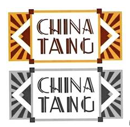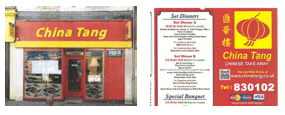Contact
June 27, 2022
Facts
The first claimant, Gnat and Company Ltd, owns the following UK trade mark, registered on 29 August 2005 for, inter alia, “Restaurant services; catering services; cafes; cafeterias; and self-service restaurants”:

The second claimant, China Tang London Ltd (CTL), runs a Cantonese restaurant called “China Tang” at the Dorchester Hotel in Park Lane. The restaurant was opened in 2005 by Sir David Tang, businessman, writer and raconteur, after whom the restaurant is named. CTL operates under a licence from Gnat.
Mr Honglu Gu runs a Chinese takeaway in Barrow-in-Furness through his company, West Lake and East Ltd (WLE). WLE started trading in 2009 under the name “China Tang”. Below are images of the shop front and a sample menu:

The sign is also used in the same ordinary typeface on WLE’s website and is not stylised.
Gnat and CTL issued proceedings against Mr Gu and WLE for infringement of the Trade Mark under ss 10(2) and 10(3) of the Trade Marks Act 1994, and for passing off.
Mr Gu and WLE denied infringement and asserted honest concurrent use. They also counterclaimed for partial revocation of the Trade Mark due to non-use insofar as it was registered for “cafes; cafeterias; and self-service restaurants” (but not restaurant or catering services).
Decision
Revocation
Gnat and CTL did not resist an amendment to the specification of the Trade Mark to delete “self-service restaurants” and did not argue that the Trade Mark had been put to genuine use in relation to cafe or cafeteria services.
However, they said that a fair specification, as discussed in Decon Laboratories Ltd v Fred Baker Scientific Ltd [2001] RPC 17, would include services provided by cafes and cafeterias.
His Honour Judge Hacon noted that the online Cambridge dictionary defines “café” as “a restaurant where simple and usually quite cheap meals are served” and “cafeteria” as “a restaurant (often in a factory, a college, or an office building) where people collect food and drink from a serving area and take it to a table themselves after paying for it”. These definitions corresponded with HHJ Hacon’s own perception of what “cafe” and “cafeteria” are taken to mean by an average consumer and confirmed his impression that the average consumer would consider both a cafe and a cafeteria to be a type of restaurant.
Therefore, HHJ Hacon said, deleting either term would, by implication, limit the scope of “restaurant services” in the specification, which would be liable to mislead. Further, in HHJ Hacon’s view “restaurant services” was not such a broad term that it should be sliced into subsets. “Restaurant services” should be given its full meaning, he said, which included restaurant services provided by cafes and cafeterias.
Accordingly, the counterclaim to limit the specification beyond the agreed deletion of “self-service restaurants” was dismissed.
Section 10(2)
In terms of similarity of services, Mr Gu and WLE said that takeaway food services were not the same as any of the services in the specification.
HHJ disagreed, finding that, as Gnat and CTL argued, takeaway services were very similar to the services in the specification. HHJ Hacon said that many restaurants offer takeaway services, especially in lower-priced restaurants. WLE also offered a delivery service, as did many restaurants. In fact, the Park Lane restaurant provided “takeaway food” to the customers of private jet companies. Accordingly, WLE’s takeaway services were similar to “restaurant services”.
As for similarity between the signs, HHJ Hacon said that the dominant and distinctive element of the Trade Mark was the words “China Tang”, which was aurally identical, and visually similar to, Mr Gu’s sign. Any perception of conceptual meaning was identical.
As for the likelihood of confusion, Mr Gu said that if there was any, then instances of confusion would have emerged by now and that WLE’s modest takeaway had little in common with the Park Lane restaurant, meaning there could be no confusion. HHJ Hacon disagreed. Following Compass Publishing BV v Compass Logistics Ltd [2004] EWHC 520 (Ch), the comparison between trade mark and sign required consideration of the sign only in the circumstances of the alleged infringement, but consideration of the trade markas used across any part of its specification, most relevantly as used for the type of product or service closest to that of the alleged infringement. Where a trade mark owner had used the mark in respect of goods or services in part of the specification different from the part closest to the alleged infringing use, that might explain a lack of confusion in the real world.
Here, the likelihood of confusion had to be approached by considering the perception of the average consumer who was aware of both: (i) low-price restaurants trading under the Trade Mark; and (ii) Mr Gu’s takeaway using the “China Tang” trading name. It also had to be assumed that the average consumer was aware that low price restaurants often provide takeaway services.
HHJ Hacon found that because of the aural identicality between the signs, the close visual similarity and the close similarity between Mr Gu’s services and the “restaurant services” of the Trade Mark specification, in particular the services of low-cost restaurants that typically offer takeaway services, there was a likelihood of confusion. Therefore, subject to honest concurrent use, the Trade Mark had been infringed under s 10(2).
Section 10(3)
Considering the issue of reputation of Gnat’s business in November or December 2009, when Mr Gu began trading, HHJ Hacon found that its market share, relative to the UK restaurant business as a whole, would have been tiny in 2009. It had only been trading for four years by the time Mr Gu began trading and it was a single restaurant. Money was spent on advertising, but the evidence did not show how it was spent. Again, in the context of the restaurant market of the whole of the UK, the sums were very small.
The overall test was whether the Trade Mark was known by a significant part of the UK public concerned with restaurant services and in HHJ Hacon’s view the evidence did not go far enough to show that. Therefore, at the end of 2009, the Trade Mark did not have a reputation within the meaning of s 10(3).
As for a link between the Trade Mark and the sign, given that a likelihood of confusion had been established, HHJ Hacon said that there was a link.
However, HHJ Hacon said that unfair advantage of the distinctive character of the Trade Mark had not been established. He disagreed with Gnat that once a link had been established, unfair advantage would inevitably follow, and Gnat had not provided any other reason or evidence to suggest that the distinctive character of the Trade Mark was being exploited.
As for Mr Gu’s use of the sign being detrimental to the distinctive character of the Trade Mark, HHJ Hacon rejected Gnat’s argument that customers of its Park Lane restaurant would get the impression that it was operating a franchise of high street takeaways. This was based on mere supposition and there was no analysis or evidence of a change in the economic behaviour of the average consumer consequent on the use of Mr Gu’s sign or evidence of a serious likelihood that such a change would occur in the future.
As a result, there was no need to consider due cause and the case under s 10(3) was dismissed.
Honest concurrent use
Mr Gu admitted that when he began trading, he had not conducted any searches, including internet searches, for the sign “China Tang” and that he had chosen it because it was his mentor’s name.
HHJ Hacon said that if Mr Gu had been a large enterprise with a trade mark department that had failed to conduct a trade mark search, it would be hard not to conclude that this failure was not in accordance with honest practices, unless there were good reasons for the failure. In HHJ Hacon’s view, there was no principled reason as to why a small business should not be held to the same standard as a larger organisation. The public register of other parties’ rights was there to be consulted.
However, failure to conduct a trade mark search was not enough on its own to deprive a defendant of an honest concurrent use defence. HHJ Hacon consulted the non-exhaustive list in Samuel Smith Old Brewery (Tadcaster) v Lee [2011] EWHC 1879 (Ch), finding that factor number (iv) in the list (whether Mr Gu knew that Gnat objected to the use of the sign or was likely to object)), factor number (v) (whether Mr Gu knew or should have appreciated that there was a likelihood of confusion) ( and factor number (ix) (whether Mr Gu had a sufficient justification for using the sign) () would all count against him.
HHJ Hacon said that he had sympathy for Mr Gu. However, in the modern climate of easy trade mark and internet searches, if a party starts to use a trading name without appropriate advice and simple searches, such use will not have been honest concurrent use without some other reason. There was no such reason in this case.
Passing off
HHJ Hacon said that Gnat’s goodwill stretched beyond London courtesy of press coverage, but it was patchy and probably did not stretch into the three-mile radius around Mr Gu’s takeaway business in Barrow, which was where all his customers came from.
Further, there was no misrepresentation, as the possibility of someone who knew of Gnat’s business then becoming aware of Mr Gu’s business and thinking there was a connection was minimal. Further, there was no evidence of any deception. Accordingly, the claim for passing off failed. (Gnat and Company Ltd v West Lake East Ltd [2022] EWHC 319 (IPEC) (16 February 2022) — to read the judgment in full, click here).
Expertise